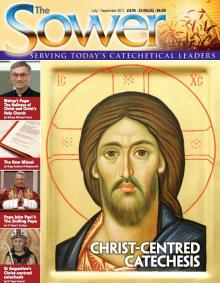Sean Innerst helps us respond to the Church’s call to place Christ at the center of our narration of salvation history.
The General Directory for Catechesis (GDC) at number 39 says, ‘Catechesis, for its part, transmits the words and deeds of Revelation; it is obliged to proclaim and narrate them and, at the same time, to make clear the profound mysteries that they contain’ (emphases added). That is only the first of several references in the GDC to a form of catechesis, the narratio or narration of salvation history, that was a standard part of the initiatory practices of the fourth and fifth century Church.i
Those practices, many of which have been revived in the modern RCIA, gave way over time to the requirements of a changing Church in which the catechetical focus became not so much adults who needed to be given a Judeo-Christian worldview to replace a Greco- Roman one, but children who had grown up in communities that were more and more shaped by a Christian vision.ii With the fading of the ancient practice of narratio, many catechists today feel incapable of responding to the obligation to narrate what God has revealed, spoken of in the GDC, because they just don’t know what a catechetical narration should look like.
In the Prologue to his early 5th century work De catechizandis rudibus (DCR), which in its newest English translation is titled Instructing Beginners in the Faith,iii St. Augustine of Hippo tells us that the narration, or narration of salvation history, which he used to catechize those newly entering the faith is intended to display ‘the central points of the faith’ and that it ‘gives us our identity as Christians.’iv He goes on to say that it represents an ‘initial grounding in the faith’ and then even that through it ‘the content of the faith is communicated’ to these newcomers.v That a half-hour to an hour-and-a-half discourse could do all that might seem a rather exalted claim, but Augustine is clear that in either a shorter or longer form, when constructed properly, the narratio will be ‘at all times perfectly complete.’vi
The rest of this online article is available for current Guild members.
This article is from The Sower and may be copied for catechetical purposes only. It may not be reprinted in another published work without the permission of Maryvale Institute. Contact [email protected]

















